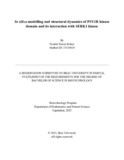| dc.contributor.advisor | Mubassir, M H M | |
| dc.contributor.author | Ruhee, Noshin Nawer | |
| dc.date.accessioned | 2022-02-27T04:25:59Z | |
| dc.date.available | 2022-02-27T04:25:59Z | |
| dc.date.copyright | 2021 | |
| dc.date.issued | 2021-09 | |
| dc.identifier.other | ID 15136019 | |
| dc.identifier.uri | http://hdl.handle.net/10361/16346 | |
| dc.description | This thesis is submitted in partial fulfillment of the requirements for the degree of Bachelor of Science in Biotechnology 2021. | en_US |
| dc.description | Catalogued from PDF version of thesis. | |
| dc.description | Includes bibliographical references (pages 96-102). | |
| dc.description.abstract | Due to plants’ immobility, they are continuously faced with different challenges from their
surroundings that also include a wide range of pathogens dealing in the environment. Hence by
unraveling the mystery behind how plants tackle all these adversities and understanding the
theory behind it would be a great step towards comprehending the mechanism that makes plant
disease resistant. The two most important ways by which defenses are activated in plants are by
structural interaction between the pathogen-associated molecular pattern (PAMP) known as the
pattern-triggered immunity (PTI) and secondly via effectors known as effector-triggered
immunity (ETI). In PTI, PRRs detecting PAMPs are employed along with the co-receptor
proteins to combat the pathogens. PSY1R, a leucine-rich repeat receptor-like kinase ( LRR-RLK)
which has only been shown to act to regulate cell expansion and growth previously, has been
recently found to have an important role in the immunity system of the plant by impacting in an
antagonistic manner on the plant triggered immunity (PTI). This research aims to acquire a better
understanding of the 3D structure of PSY1R receptor kinase and to predict its probable active
sites for developing a clear perception of its impact on plant immunity by observing its
interaction with receptor SERK1 kinase. Keeping this purpose in mind, modelling of these
kinase proteins followed by docking and molecular dynamics (MD) simulation using
GROMACS software suite have been performed. Different tools and servers have been used for
the modelling of PSY1R and SERK1 kinase generating a number of 3D models. After
undergoing verification processes, followed by observing the RMSD and radius of gyration
graph at 5ns MD simulation the best model for PSY1R kinase and SERK1 kinase have been
selected for docking. The docking result shows that PSY1R and SERK1 kinases interact on
different levels with forming different kinds of bonds both before and after the MD simulation
conducted at 10ns. The interactions between the two proteins were also analyzed using the
protein interaction calculator (PIC) and it has been found that after the MD simulation the
number of hydrogen bonds formed between them almost became half. Starting with 57 H-bonds
before the simulation, whereas only 21 afterward. These changes are significant indicators of
conformational changes that take place over the simulation period and are vital in understanding
the early events of PTI by the receptor kinase protein. | en_US |
| dc.description.statementofresponsibility | Noshin Nawer Ruhee | |
| dc.format.extent | 102 pages | |
| dc.language.iso | en | en_US |
| dc.publisher | Brac University | en_US |
| dc.rights | Brac University theses are protected by copyright. They may be viewed from this source for any purpose, but reproduction or distribution in any format is prohibited without written permission. | |
| dc.subject | PSY1R | en_US |
| dc.subject | SERK1 kinase | en_US |
| dc.subject | Kinase domain | en_US |
| dc.subject | Plant defenses | en_US |
| dc.subject.lcsh | Protein Kinases | |
| dc.title | In silico modelling and structural dynamics of PSY1R kinase domain and its interaction with SERK1 kinase | en_US |
| dc.type | Thesis | en_US |
| dc.contributor.department | Department of Mathematics and Natural Sciences, Brac University | |
| dc.description.degree | B. Biotechnology | |

